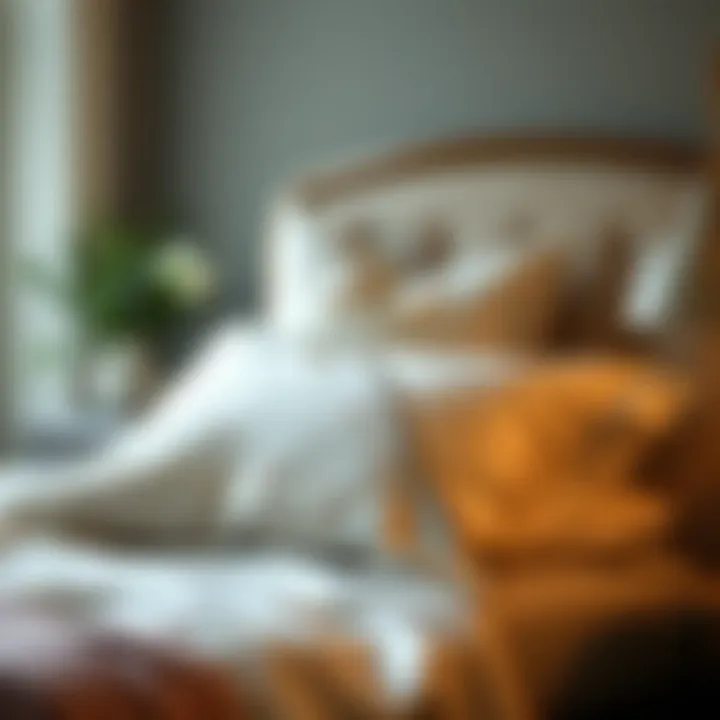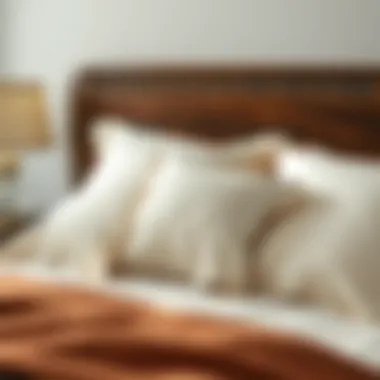Ultimate Guide to Cleaning Your Silk Pillowcases


Intro
Silk pillowcases have gained a reputation not merely for their luxurious feel but also for their benefits to skin and hair. They maintain lower moisture levels compared to cotton, helping you wake up looking refreshed, with fewer wrinkles and frizz. However, the delicate nature of silk requires specialized care to ensure its longevity and aesthetic appeal. In this guide, we will delve into the best practices for maintaining silk pillowcases, ensuring they remain as stunning and beneficial as the first day you laid your head upon them.
Here, we'll explore essential cleaning methods, the perfect products to use, and tips that can help you keep your pillowcases in top shape. With the right approach, you can preserve the charm and quality of silk, making your investment worthwhile for years to come.
For those who are homeowners, design enthusiasts, or anyone who simply wishes to upgrade their bedding experience, understanding how to properly care for silk pillowcases is paramount. Beyond aesthetics, the hygiene aspect cannot be ignored; maintaining cleanliness is necessary for both your health and comfort.
This guide is structured to offer a comprehensive overview, equipping you with the knowledge you need. Let’s start with the foundational aspects of caring for silk pillowcases effectively.
Understanding Silk
When it comes to the realm of bedding, silk pillowcases stand as a pinnacle of luxury. Yet, what exactly sets silk apart from other fabrics, and why should it be a priority for those who value comfort and style? Understanding the nature of silk, as well as its benefits, not only enhances one’s appreciation for this fabric but also informs proper care techniques. This section dives into these critical aspects, providing insight that will enrich your knowledge and help maintain the quality of your silk pillowcases.
Nature of Silk Fabric
Silk is a natural protein fiber, primarily produced by silkworms during their cocoon phase. The fibers are luxurious, resulting in a smooth and soft texture. Its origin traces back thousands of years, notably in China, where harvesting and weaving techniques were refined to create the exquisite material we recognize today.
A defining characteristic of silk is its permeability, which allows it to breathe effectively. This unique quality contributes to temperature regulation, keeping you cool in the summer and warm in winter. Plus, its glossy finish offers a touch of elegance that is often unmatched by synthetic alternatives.
However, silk isn't just a pretty face; it’s also known for its resilience. Despite being lightweight, it possesses remarkable durability, which can withstand many cycles of washing if cared for properly. Yet, this does come with a caveat. Knowing how to handle silk with gentle care is essential to prolong its lifespan.
Benefits of Silk Pillowcases
Investing in silk pillowcases comes with a slew of benefits. Firstly, let’s talk skin. Silk is less absorbent than cotton, meaning it holds onto more moisture. This quality can help reduce skin irritation and dryness, potentially improving skin texture over time. Many dermatologists endorse silk pillowcases for those struggling with acne or other skin issues as they may cause less friction, leading to fewer breakouts.
Hair also stands to gain from silk pillowcases. The smooth surface reduces friction that can cause hair damage, split ends, and tangling. If you’ve ever woken up with a frizzy mess on your head, switching to silk might just solve that dilemma. Commonly hailed as a great alternative to traditional cotton, silk supports maintaining hairstyles longer and minimizes the need for excessive heat styling.
Moreover, silk is hypoallergenic, making it an excellent choice for individuals with allergies or sensitive skin. Dust mites and other allergens can easily cling to fabric, but silk's unique properties discourage this accumulation, offering a cleaner sleeping environment.
"Choosing silk pillowcases isn’t simply about luxury; it’s an investment in health and well-being."
In summary, the nature of silk fabric and its multitude of benefits illustrate why silk pillowcases deserve a spot in your bedroom. Understanding these fundamentals will not only make cleaning them easier but also forge a deeper appreciation for their luxurious qualities.
Importance of Cleaning
Cleaning silk pillowcases goes beyond mere maintenance; it is an essential part of preserving the fabric's luxurious feel and aesthetic charm. Silk, being a natural fiber, can harbor dust mites, allergens, and oils from our skin and hair, making regular cleaning critical for both hygiene and longevity.
Hygiene Considerations
First on the list is hygiene. Silk pillowcases, often coming in direct contact with our face for hours on end, require stringent cleaning practices to mitigate potential health concerns. Over time, dirt and oil can accumulate, and if left unchecked, these can lead to skin issues such as acne or irritation. Allergens like dust mites thrive in places where skin flakes and moisture are present. According to studies, maintaining clean bedding can significantly impact overall health, reducing allergy symptoms and promoting better sleep.
When washing silk pillowcases, it’s vital to use a gentle approach. Hand washing is often recommended as it minimizes wear on the delicate fibers, ensuring that you do not compromise the fabric's integrity. If machine washing is unavoidable, using a mesh bag can provide an extra layer of protection, preventing snagging.
Moreover, employing a mild detergent specifically formulated for silk can help in removing impurities without stripping the fabric of its natural oils. For those who prefer a more natural approach, vinegar can serve as an effective rinse, helping to break down residues while also imparting a subtle shine.
"Cleanliness is not just about removing dirt; it's a step towards a healthier living space."
Maintaining Quality
Apart from hygiene, maintaining the quality of silk pillowcases is paramount. Silk is known for its sheen and softness; however, its luxurious attributes can diminish over time if proper care is neglected. Each wash without careful consideration chips away at the luster and structure of the fibers.


To keep silk pillowcases looking brand new, frequent, but careful cleaning rituals are necessary. Here are some key tips:
- Opt for Cold Water: Hot water can cause silk to lose its natural properties and lead to fading. Cold water preserves color and prevents shrinkage.
- Limit Exposure to Sunlight: When drying, avoid direct sunlight as UV rays can fade the color and degrade the fibers.
- Avoid Abrasive Materials: When it’s time to dry off your pillowcases, use a soft towel rather than hanging them roughly. Gentle handling ensures that you maintain the texture of the silk.
By cultivating these carefully structured cleaning habits, the silk pillowcases not only retain their intrinsic beauty but also last longer, providing you with uninterrupted comfort for years to come.
Materials Needed for Cleaning
When it comes to maintaining the luxurious quality of silk pillowcases, understanding the materials required for proper cleaning is absolutely crucial. Using the right supplies not only preserves the fabric's integrity but also enhances its lifespan. Silk, being a delicate natural fabric, requires careful handling and specialized products to ensure it remains soft, lustrous, and free from damage.
Essential Cleaning Supplies
To embark on the cleaning journey for your silk pillowcases, gather these essential supplies:
- Cold Water: Ideal for rinsing and washing silk, as hot water can lead to unwanted shrinkage or damage.
- Soft Microfiber Cloths: These are gentle on silk and effective for patting dry after washing.
- Wash Basin or Sink: A clean, small basin is perfect for handwashing without risking the pillowcases getting tangled in washing machines.
Using the appropriate materials is key. Avoid typical household brushes or abrasive sponges that can snag and ruin the silk fibers. Instead, utilize only soft tools that won't cause any friction.
Recommended Detergents
Selecting a suitable detergent is paramount when dealing with silk. Regular laundry detergents can be too harsh and may strip silk of its natural oils, leading to a dull appearance.
Here are some options that work wonderfully:
- Gentle Silk Detergent: Brands like The Laundress or Eucalan are tailored specifically for delicate fabrics, ensuring a gentle clean without compromising quality.
- Baby Shampoo: An unexpected but effective choice, baby shampoo is mild and non-irritating, making it suitable for silk.
- pH-Neutral Cleaners: Look for products labeled as pH-neutral, as they work well with silk while maintaining its pristine state.
"Using the right kind of detergent is as important as the washing technique itself. It’s a matter of ensuring your silk stays as dazzling as the day you bought it."
By equipping yourself with the right cleaning supplies and a suitable detergent, you set yourself up for success in keeping your silk pillowcases in top-notch condition. Whether you’re preparing for special occasions or simply enjoy the touch of luxury daily, maintaining silk requires some thoughtful choices that pay off in the end.
Cleaning Methods
Cleaning methods for silk pillowcases play a crucial role in preserving the fabric's natural beauty and longevity. Understanding how to properly care for your silk not only ensures hygiene but also maintains the integrity of this luxurious fabric, which can easily be damaged by improper washing techniques. It's vital to recognize that silk, being a delicate material, requires special attention during the cleaning process to avoid compromising its luxurious quality.
Hand Washing Techniques
Hand washing is often considered the gentlest way to clean silk pillowcases. This method minimizes agitation and helps to avoid stretching or damaging the fibers. Here’s how to effectively hand wash:
- Prepare Your Washing Solution: Fill a basin with lukewarm water and add a small amount of a gentle detergent suitable for silk. Avoid using bleach or heavy cleaners, which can harm the fabric.
- Submerge the Pillowcase: Gently submerge the silk pillowcase in the water, allowing it to absorb the soapy mixture. Avoid scrubbing or twisting the fabric; instead, gently agitate the water to clean the pillowcase.
- Rinse Thoroughly: Once clean, rinse the pillowcase under cool, running water until all soap is removed. This step is important to prevent residue build-up, which can lead to degradation over time.
- Drying: Carefully press the water out without wringing. Lay the pillowcase flat on a clean, dry towel and roll it up to absorb excess moisture before air drying in a shaded area.
Hand washing may take a bit longer, but the results often reflect your care for the silk. This method also limits exposure to rough surfaces or extreme temperatures.
Machine Washing Considerations
While hand washing is preferred, sometimes a machine wash is inevitable. If you go this route, it’s essential to follow a few key guidelines:
- Use a Mesh Bag: Place your silk pillowcases in a mesh laundry bag to protect them from snagging on other items in the wash cycle.
- Select the Right Settings: Opt for the delicate or gentle cycle on your washing machine. Using cold water is crucial, as hot water can easily shrink or damage silk.
- Choose Wisely with Detergent: As with hand washing, use a mild detergent specifically formulated for silk or delicate fabrics. Steer clear of harsh detergents or fabric softeners that may leave residues.
Even with these precautions, machine washing poses risks. Excessive agitation can cause fabric distortion, fading, or even yarn breakage, so always weigh the pros and cons.
Spot Cleaning Strategies
Sometimes, you might only need to deal with a small stain rather than a full wash. Spot cleaning can effectively target specific areas while preserving the overall fabric. Here’s a straightforward approach to spot cleaning your silk pillowcase:


- Act Quickly: As with most stains, addressing them promptly is crucial. The longer a stain sits, the harder it can become to clean.
- Dab, Don’t Rub: Using a clean, white cloth, gently dab the stained area with a little water or a mixture of water and mild detergent. Rubbing can spread the stain or embed it deeper into the fabric.
- Rinse Carefully: A light rinse with cool water can be beneficial after treating. Just dampen the cloth again and dab the area to remove any soap residue.
- Let It Air Dry: After spot cleaning, allow the area to air dry completely before using the pillowcase again.
Spot cleaning is a practical solution when handling unexpected spills or stains, preserving the silk's appearance without requiring a full wash.
"When it comes to silk care, a little bit of prevention can go a long way. Stay proactive, and your pillowcases will thank you!"
By understanding and applying the right cleaning methods, silk pillowcases can maintain their elegance and comfort for years to come. Taking these steps ensures not just cleanliness but also the preservation of that luxurious feel that silk is known for.
Drying Techniques
Proper drying is paramount when it comes to maintaining the integrity of silk pillowcases. The way you dry these delicate items can make a significant difference, not just in how long they last, but also in retaining their luxurious appearance and feel. Silk, being a fine fabric, can easily lose its luster or become misshapen if not dried correctly. Therefore, understanding the best drying techniques is essential for anyone aiming to pamper themselves with the richness of silk.
Air Drying Methods
Air drying is often considered the gentle giant in the world of silk care. It takes a bit longer than using a dryer, but it significantly reduces the risk of damage. Essentially, it’s about letting nature do its work. Here’s how to do it right:
- Prepare Your Space: Choose a well-ventilated area away from direct sunlight. Sunlight can fade the color and weaken fibers. Look for a soft surface to hang or lay your pillowcases flat.
- Shape and Position: If the pillowcases are wet, reshape them by pulling gently on the edges. This helps them dry smoothly without wrinkles. Lay them flat on a clean, dry towel or a mesh drying rack to allow air circulation.
- Avoid Hang Drying with Clothespins: If you must hang them, use padded hangers or clips that won’t damage the fabric. Conventional clothespins can leave unsightly marks that are hard to remove.
Using these methods will help in preserving your silk's quality.
Tip: If you live in a humid environment, consider using a fan to help with airflow.
Using a Dryer: Pros and Cons
Using a dryer for silk pillowcases is a double-edged sword. On one hand, it’s quick and convenient; on the other, it comes with risks that could lead to disappointment. Here’s a breakdown of the pros and cons:
Pros:
- Speed: A dryer can quickly dry your pillowcases in very little time, great for those with a packed schedule.
- Even Drying: It can help ensure that all parts of the fabric dry evenly.
Cons:
- Heat Damage: Silk is highly sensitive to heat. A standard dryer can lead to shrinkage and even fabric burn if it's not set to low heat or delicate settings.
- Static Cling: The dryer may cause static electricity, making the surface of the silk feel rough instead of soft.
To mitigate risks while using a dryer, stick to the following guidelines:
- Always use a low or delicate heat setting.
- Consider placing a dryer ball or a clean tennis ball in the dryer to prevent the pillowcases from clumping.
Understanding these factors is crucial to avoid those heartbreak moments when your once-beautiful silk pillowcases come out looking less than perfect.
Storing Silk Pillowcases
When it comes to maintaining the luxurious feel and appearance of silk pillowcases, how you store them can’t be emphasized enough. Proper storage not only keeps them looking immaculate but also extends their lifespan. Silk, being a delicate fabric, needs gentler handling in every aspect, particularly during storage.
One of the main reasons to pay close attention to how we store silk pillowcases is to protect them from potential damage. Exposure to excessive light, heat, or moisture can lead to fading, mildew, or even deterioration of the fibers. Beyond that, silk is prone to accumulating dust and unwanted odors if not properly stowed away. All these factors contribute not just to the aesthetics, but also to the hygiene of the pillowcases.
In the following sections, we will delve into proper storage techniques that can help ensure your silk pillowcases stay in pristine condition, alongside tips to avoid damaging them during storage.
Proper Storage Techniques
- Use Breathable Storage Bags: Consider placing your silk pillowcases in cotton or linen storage bags rather than plastic ones. While plastic might seem convenient, it traps moisture, which can lead to mold growth. Breathable materials allow airflow, keeping the silk fresh.
- Keep Away from Direct Sunlight: Sunlight can cause the colors of silk to fade faster than you’d like. Choose a dark or shaded area for storage. Consider a drawer or a closed bin to shield your silk from light.
- Maintain a Cool and Dry Environment: Extreme temperatures or humidity can cause silk to lose its luster. Ideally, aim for a temperature range of about 60-70°F with humidity levels between 40-60%. A climate-controlled space is ideal for silk storage.
- Fold Instead of Hanging: Hanging might stretch out the fibers over time. Instead, neatly fold your pillowcases and lay them flat in your storage area to maintain their shape.
Avoiding Damage During Storage


- Avoid Heavy Weight on Top: Don’t pile other items on top of your silk pillowcases. The weight can create wrinkles or lead to indentations that may not easily come out. Keep them at the top layer or at least ensure they’re on a soft surface.
- Separate Colors: If you have different colored silk pillowcases, it's wise to store them separately to prevent color bleeding. Even slight contacts can transfer dyes, especially if moisture is present.
"Creating a safe and comfortable storage environment is key to preserving the elegance of silk pillowcases. Never underestimate the impact of moisture and pressure!"
- Regular Inspection: Periodically check on your stored pillowcases to ensure they remain dry and free of pests. A quick eye on your stored items can save you from bigger headaches later on.
By following these simple yet effective storage techniques, you can ensure your silk pillowcases stay as beautiful as the day you bought them. Keeping them safeguarded will enhance their appeal and keep your sleeping space looking sharp and sophisticated.
Common Mistakes to Avoid
When it comes to the care and maintenance of silk pillowcases, understanding the common pitfalls can make all the difference. Many homeowners and enthusiasts alike may think they are treating their silk with the utmost respect, but it’s often a subtle oversight that leads to unintended damage. A careful approach not only extends the life of these luxurious fabrics but also retains their elegance and charm. Let's delve into two key mistakes often made and understand how to circumvent them properly.
Overwashing Concerns
One prevalent mistake many make is overwashing their silk pillowcases. Just like a delicate flower that flourishes with minimal disturbance, silk thrives with less frequent washing. Overwashing can strip the natural sheen and luster of the fabric, leaving it dull and lifeless.
Why is this a problem? Silk is known for its protein structure, much like our hair. Too much exposure to water and soap can weaken these fibers, leading to fraying or even holes over time. Generally, it’s advisable to wash silk pillowcases after several uses. Keeping tabs on scents or stains can help determine when a wash is truly necessary. If the pillowcase seems clean, it often is.
"Silk thrives in the quiet; too much agitation and it loses its grace."
If a wash is in order, opting for a gentle hand wash or using a machine on the delicate cycle with cold water can help maintain the fabric’s integrity. Also, using the right detergent specifically designed for silk can make a world of difference.
Tips to Avoid Overwashing:
- Establish a Routine: Wash silk pillowcases every two to three weeks unless visibly soiled.
- Monitor Odors: Trust your nose; if there’s no smell, it’s likely clean.
- Spot Clean when Possible: For minor stains, spot cleaning is your best friend to avoid a full wash.
Ignoring Fabric Care Labels
Another significant misstep is neglecting the fabric care labels, which are a treasure trove of information provided by manufacturers. These labels give precise instructions on how to care for your silk, based on its unique characteristics. Ignoring these guidelines can result in mishaps that are easily avoidable.
What often happens is that the washing methods applied do not align with the actual requirements of the silk. For instance, some might think all silk is the same, but different types, such as charmeuse, satin, and taffeta, may have varied care needs.
The Importance of Reading the Labels:
The fabric care label typically indicates washing instructions, drying methods, and even ironing guidelines. Not adhering to these suggestions can lead to fabric shrinkage, increased wear, or - worst-case scenario - complete ruin.
Best Practices with Care Labels:
- Always Read Before Washing: Familiarize yourself with the specific instructions before proceeding with cleansing your silk pillowcase.
- Pick the Right Method: If the label advises dry cleaning, taking that route can preserve your silk better than home washing.
- Comply with Heat Levels: Precise temperature settings, whether in washing or ironing, are critical for silk care.
The End
Cleaning silk pillowcases may seem like a small component of home care, yet it carries significant weight in terms of both hygiene and the longevity of the fabric. Regular cleaning is not just about aesthetics; it plays a pivotal role in preventing the buildup of dust mites, oils, and other allergens which can compromise your sleep quality and skin health. Moreover, by adhering to the appropriate care guidelines, you help maintain the luxurious feel and appearance of your silk pillowcases, ensuring that they retain their charm over time.
In this article, we’ve discussed crucial points regarding the care of silk textile, focusing particularly on effective cleaning strategies. As silk is a natural protein fiber, it requires specialized treatment. Ignoring this could lead to fading, loss of texture, or even irreversible damage.
Recap of Key Takeaways
- Regular Cleaning: Regularly washing your silk pillowcases is essential for hygiene and preservation.
- Gentle Methods: Whether hand washing or machine washing, choose gentle methods suitable for silk to avoid damage.
- Drying and Storage: Proper drying techniques, such as air drying, along with smart storage choices, help maintain silk's quality.
"A stitch in time saves nine" – this old adage rings true for silk pillowcase care. A little attention goes a long way!
- Avoid Overwashing: Too frequent washing can wear out the fabric.
- Read Care Labels: Always check labels for specific instructions, as each silk item may have unique requirements.
Final Thoughts on Silk Care
Looking after silk pillowcases is more than just handling a luxury item; it's about enriching your quality of life. Silk is not only beautiful but has inherent benefits for your skin and hair, reducing irritation and enhancing moisture retention. When you invest in proper care for your silk pillowcases, you essentially invest in a better night’s sleep and an elevated lifestyle.
Approach cleaning with respect to the fabric's nature, nurturing it with gentle products, and handling it delicately. In doing so, you preserve its elegance, functionality, and therapeutic advantages for years. Homeowners and design enthusiasts alike will appreciate the beauty and benefits that well-maintained silk pillowcases bring into their lives.



